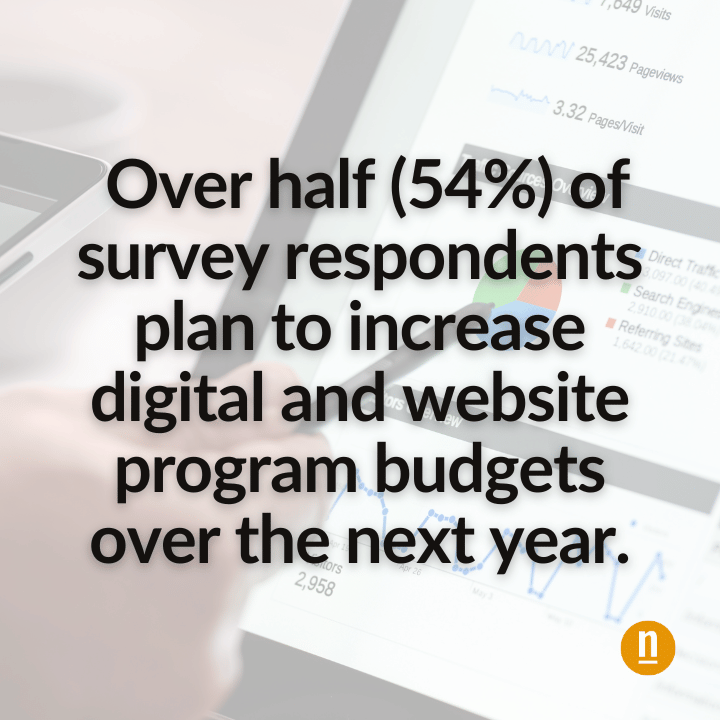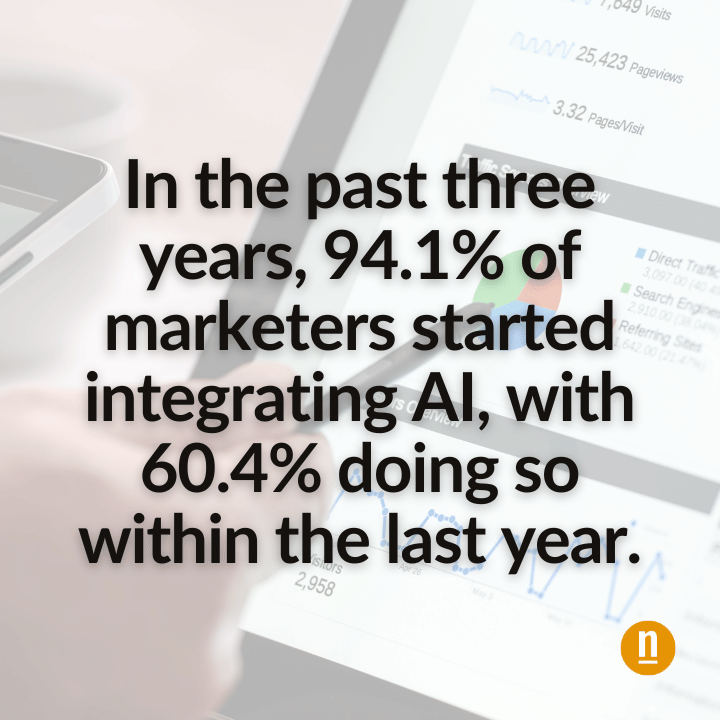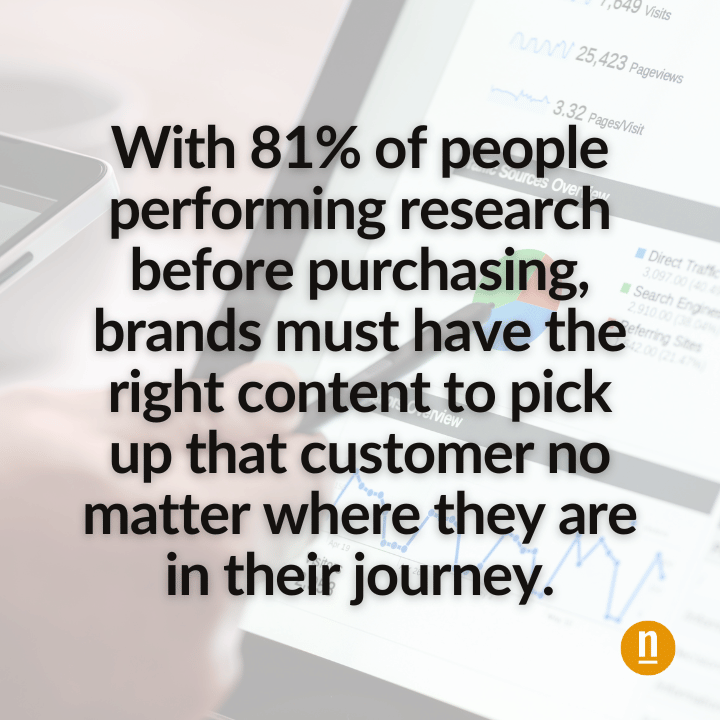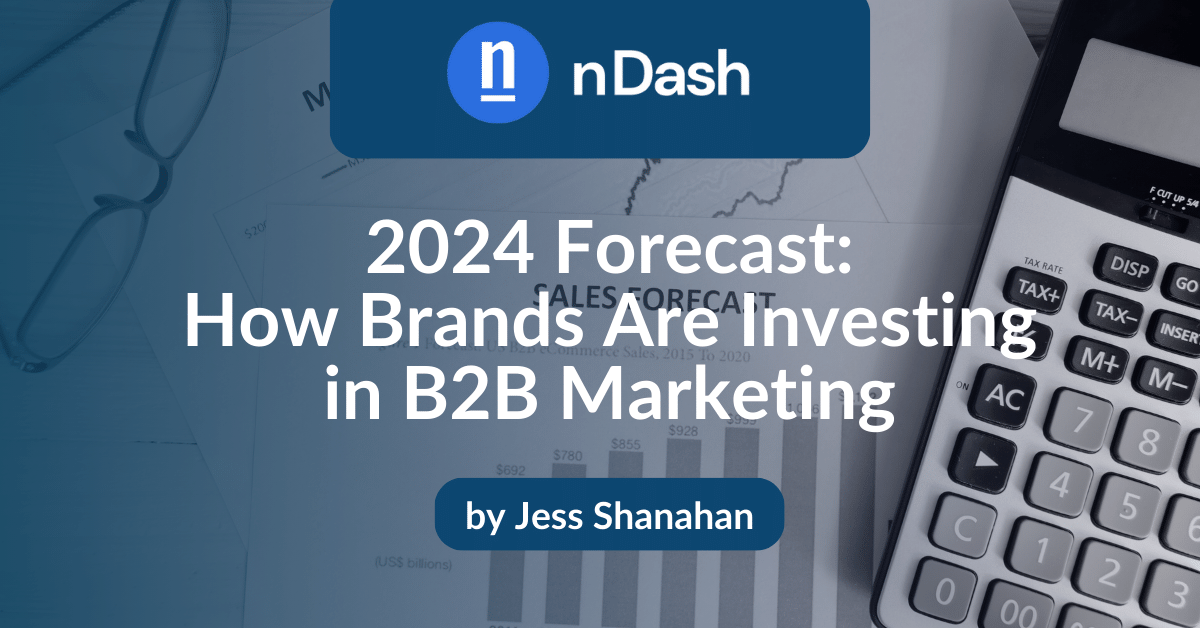There’s been a sense of uncertainty since the chaos of the COVID-19 pandemic. But the last few years have seen B2B marketing investment increase as the world recovers. This shift presents a welcome opportunity for brands. However, the threat of an economic downturn has introduced a newfound sense of fragility into the mix.
For companies considering whether investment in marketing is still the way forward, everything points to yes, as buyers demand more personalization from the brands they interact with.
Amid uncertain times, with global events compounding skills shortages and hiring challenges, investment in marketing is more important than ever. Businesses need marketing to bring in new leads and improve the customer experience.
That’s where B2B brands are spending their budget in 2024.
Digital-First B2B Marketing Strategies
 According to Forrester’s 2023 B2B Brand and Communications Survey, there’s a clear focus on digital marketing. Over half (54%) of survey respondents plan to increase digital and website program budgets over the next year. Given the growing importance of digital channels in business, this is no surprise to most. This trend is a long-running one that’s seen brands consistently put more focus on their content strategies.
According to Forrester’s 2023 B2B Brand and Communications Survey, there’s a clear focus on digital marketing. Over half (54%) of survey respondents plan to increase digital and website program budgets over the next year. Given the growing importance of digital channels in business, this is no surprise to most. This trend is a long-running one that’s seen brands consistently put more focus on their content strategies.
It comes from how all buyers, consumers, and businesses interact with brands. Whether through social media, newsletters, or a targeted ad, digital is the best way to reach potential and existing customers.
Creative services are another key area where brands intend to increase investment, with 47% of respondents planning to increase those budgets. Creatives such as copywriters, graphic designers, and videographers are essential to content strategies. Their work helps brands stand out in a competitive marketplace.
These statistics show confidence in the role of brand websites and other digital channels. Organizations’ continued investment in these areas shows that they will remain essential for customer experience and revenue generation. This investment is a clear sign of the importance of these areas to organizations.
Increased Freelance Budget
 The focus on digital-first strategies is excellent news for freelancers with skills in these areas. Because of the cost of living crisis and the threat of recession, businesses have slowed hiring full-time staff. As a result, businesses need more specialist marketing skills.
The focus on digital-first strategies is excellent news for freelancers with skills in these areas. Because of the cost of living crisis and the threat of recession, businesses have slowed hiring full-time staff. As a result, businesses need more specialist marketing skills.
Nearly 50% of executives recognize this. So, they’re turning to freelance talent to fill skills gaps left by the hiring slowdown and difficulties finding suitable candidates.
With so many fantastic freelancers available, brands are increasingly hiring them to add new strengths and skills to their teams. That’s especially true for freelancers with experience in specific industries or formats.
Content Leads Brand Investment
The power of content marketing consistently shows itself in how brands communicate with customers. It’s no surprise to see a continuation of the long-term trend of content investment. And the upward trend in how B2B marketing leaders invest in brand communications is quite clear.
Consistent content is crucial because the sales process can take as many as 20 touchpoints. The breadth of this type of content is vast, covering everything from newsletters to blog posts to whitepapers.
All these formats serve different purposes, from brand awareness to lead generation to direct sales. Organizations should look more deeply into their customer journey before deciding to up their content budget. Considering those 20 touchpoints, ask yourself how you’ll communicate with your customers to help move them through the sales funnel.
Impact of AI on Content Creation and B2B Marketing
It’s impossible to talk about B2B marketing spend without considering the impact of AI. Take ChatGPT, for example. It currently has 100+ million users, and the website has nearly 1.5 billion monthly visitors. These are huge numbers that show just how quickly we’ve been able to integrate these tools into our work.
Redefining Strategies: The Emergence of AI in Marketing and B2B Marketing Content
 In the past three years, 94.1% of marketers started integrating AI, with 60.4% doing so within the last year. Around 57% of B2B marketers favor AI for chatbot automation, allowing them to better understand and serve their customers.
In the past three years, 94.1% of marketers started integrating AI, with 60.4% doing so within the last year. Around 57% of B2B marketers favor AI for chatbot automation, allowing them to better understand and serve their customers.
The use of AI in content creation is also picking up. Tools like ChatGPT give marketers the ability to increase their work rate significantly. Approximately 44% of small businesses use AI for content creation. However, not as many people as you may think are using it to create articles from start to finish. It’s become clear that the quality of content solely generated by AI isn’t quite up to par.
People are generally quite divided on AI-generated content — 44% believe it matches human quality, but 40% disagree. Marketers are increasingly bringing AI into their content creation processes, but they’re not yet using it to create content directly. That’s understandable, given that Google penalizes copied-and-pasted AI content that does not serve the reader.
Instead, B2B marketers invest in AI to support segmentation, automation, outlining, and idea generation. So, even though businesses are investing over 20% of digital budgets in AI, it doesn’t seem to affect freelance hiring. Executives reported outsourcing 20.2% of their activities, which could rise another 5% by the end of 2024.
Generative AI Becomes the New Normal for B2B Marketing
It’s not just ChatGPT that has become an important tool for marketers. Generative AI can also create stunning imagery for graphics or social media use. Midjourney is a Discord image-based generation tool. Most people use it for personal reasons, with 77% saying they use it outside of work. However, there’s a growing trend of professional use, with 32% of users saying they use Midjourney for utility purposes.
Grammarly, Adobe Photoshop, Canva, and Salesforce are all popular tools using AI. It’s no wonder that marketers are picking up AI so rapidly.
Investment in B2B Marketing is Vital
No matter the industry, B2B marketers must invest in brand communication to support the customer journey. B2B buyers are getting used to a personalized and seamless service supported by the right technology and content. Brands that don’t follow this trend and fail to invest in these channels may soon lag.
Strategic Storytelling: How Advanced Tech Integration is Redefining B2B Marketing Content
McKinsey predicts that investment in marketing technology to improve customer experience will increase in 2024. With the right technology to better understand the customer journey and improve personalization, content presents a huge opportunity.
 With 81% of people performing research before purchasing, brands must have the right content to pick up that customer no matter where they are in their journey. A variety of content is important, too, as 47% of people view three to five pieces of content from a brand before even speaking to a salesperson.
With 81% of people performing research before purchasing, brands must have the right content to pick up that customer no matter where they are in their journey. A variety of content is important, too, as 47% of people view three to five pieces of content from a brand before even speaking to a salesperson.
Brands must invest in technology to find, understand, and personalize content for their customers. But they can’t forget about the content itself. This means ensuring appropriate content for all stages in the sales funnel reaching potential customers across different channels.
For example, those three to five pieces of content might include:
- LinkedIn posts about the brand’s values
- An article that outlines solutions to the main challenge its customers are facing
- Targeted advertising about the product or service that can solve that challenge
- A report on the wider industry that shows the brand’s expertise
- Newsletters with a personalized offer and a call to action to speak to someone
Digital Presence and Customer Experience: The New Frontier in B2B Marketing
All this helps the potential customer better understand the brand and what it can offer while providing value early on. If B2B buyers trust the expertise of the companies they interact with, they will be more likely to buy when the time is right. Even after the customer acquisition process, content still plays a pivotal role and shouldn’t be overlooked by marketers. It can help bring in repeat customers, encourage referrals, and improve customer support efforts.
For example, self-service FAQ content, chatbots, and support documentation can improve the customer experience. It gives customers exactly what they need without picking up the phone. It also frees up customer service staff from answering simple questions. That, in turn, reduces wait times for customers with more complex queries who need to speak to someone.
The brands that successfully embrace digital marketing in 2024 will be able to slip into the gaps left by the tech brands that faltered in 2023. Due to reduced competition, B2B buyers are more open to content and communication that helps them make informed purchasing decisions. This presents a significant opportunity for B2B marketers to acquire new customers and boost revenue.
Navigating the Future: B2B Marketing Trends Set to Dominate 2024
B2B marketing in 2024 is poised for a strong year, with content strategies at the forefront of customer experience innovation. B2B brands have access to a wealth of technology and freelance talent for creating personalized, engaging, and informative content. This content can meet the needs of their audience at every stage of the customer journey.
Contact us today to learn how our talent pool can help you achieve your B2B marketing goals.
About the author:
 Jess Shanahan specializes in business, motoring, and technology features. Some of her past clients include Cybereason, Goodyear Tire, ETQ, and Jaguar Land Rover. Hire Jess for your next automotive tech assignment today!
Jess Shanahan specializes in business, motoring, and technology features. Some of her past clients include Cybereason, Goodyear Tire, ETQ, and Jaguar Land Rover. Hire Jess for your next automotive tech assignment today!
